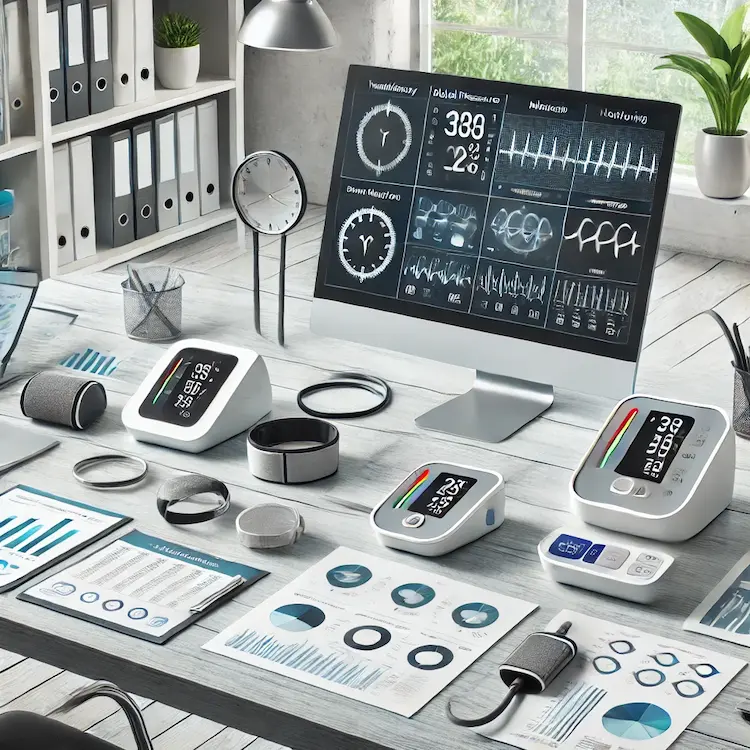High blood pressure, or hypertension, affects nearly 1.3 billion people globally and is a silent killer, often showing no symptoms until significant damage is done. Traditional blood pressure readings taken in a clinic provide only a snapshot, missing critical fluctuations throughout the day. 24-hour blood pressure monitoring (ABPM) is a revolutionary tool that gives a complete picture of blood pressure behavior, helping diagnose, manage, and prevent hypertension-related complications more effectively.
What is 24-Hour Blood Pressure Monitoring?
24-hour blood pressure monitoring (ABPM) is a method where a portable device tracks your blood pressure at regular intervals over a 24-hour period. This technology provides a comprehensive profile of your blood pressure during daily activities and sleep, offering unmatched insights compared to traditional methods.
How It Works
- Device Setup:
- A lightweight, portable monitor is strapped around your waist.
- A cuff is placed on your arm, which inflates at preset intervals (usually every 15–30 minutes).
- Continuous Tracking:
- The device measures blood pressure throughout the day and night.
- Readings are stored and analyzed for patterns.
- Results Analysis:
- The recorded data is reviewed by a healthcare provider to identify abnormalities and trends.

Common Conditions Identified
- White Coat Hypertension: Elevated blood pressure in clinical settings but normal at home.
- Masked Hypertension: Normal readings in clinics but high during daily activities.
- Nocturnal Hypertension: Elevated blood pressure during sleep, a key predictor of cardiovascular events.
Why is 24-Hour Blood Pressure Monitoring Important?
Accurate Diagnosis
ABPM reveals blood pressure variations missed in a single clinic visit. For example:
- Studies show that 20–30% of individuals with high clinic blood pressure actually have white coat hypertension, leading to unnecessary treatments.
Improved Treatment Plans
Continuous monitoring allows doctors to:
- Adjust medication based on daily blood pressure patterns.
- Evaluate the effectiveness of prescribed treatments in real-life settings.
Prevention of Long-Term Health Risks
Detecting abnormal patterns early helps reduce risks of:
- Heart attack
- Stroke
- Kidney damage
Comparison of Monitoring Methods
| Feature | Traditional Monitoring | ABPM |
|---|---|---|
| Frequency of Readings | 1–2 times in a clinic | 50–100 times in 24 hours |
| Diagnosis Accuracy | Limited | High |
| Detection of Nighttime Issues | No | Yes |
| Impact on Daily Activities | Minimal | Requires wearing a device |
Traditional methods are useful for initial screening, but ABPM is indispensable for a comprehensive evaluation.
Devices Used for ABPM
1. Traditional ABPM Devices
- Worn around the waist with an arm cuff.
- Suitable for clinical-grade accuracy.
- Drawback: Can be bulky and disrupt sleep for some users.
2. Smart Blood Pressure Monitors
- Feature real-time data synchronization with apps.
- Offer lifestyle tips based on patterns.
- Best for tech-savvy individuals.
3. Wearable Blood Pressure Monitors
- Lightweight and discreet, resembling a wristwatch.
- Suitable for casual users or those who prioritize comfort.
- Still improving in accuracy compared to ABPM devices.
Health and Societal Impacts
Health Impacts
- Early Detection: ABPM detects hidden hypertension earlier than traditional methods, reducing complications.
- Improved Outcomes: Effective blood pressure management can lower the risk of stroke by up to 40% and heart disease by 25% (source: WHO).
Societal Impacts
- Reduced Healthcare Costs: Preventing complications saves billions annually in hospitalizations and treatments.
- Better Productivity: Healthier individuals contribute more effectively to the economy.
Practical Tips for ABPM
Before the Test
- Avoid alcohol, caffeine, and smoking at least 24 hours before the test.
- Wear comfortable, loose-fitting clothing for easy device setup.
During the Test
- Continue daily activities but avoid excessive physical exertion.
- Keep a diary of activities, meals, and symptoms to correlate with readings.
After the Test
- Discuss your results in detail with your healthcare provider.
- Use insights to make lifestyle changes, such as reducing salt intake, exercising regularly, and managing stress.
Key Takeaways
- ABPM provides detailed insights into blood pressure fluctuations over a full day, including during sleep.
- It enhances diagnostic accuracy, helping doctors identify hidden patterns and make personalized treatment plans.
- Combining ABPM with lifestyle modifications can drastically improve health outcomes.
By embracing ABPM, individuals take a proactive approach to understanding and managing their cardiovascular health.


